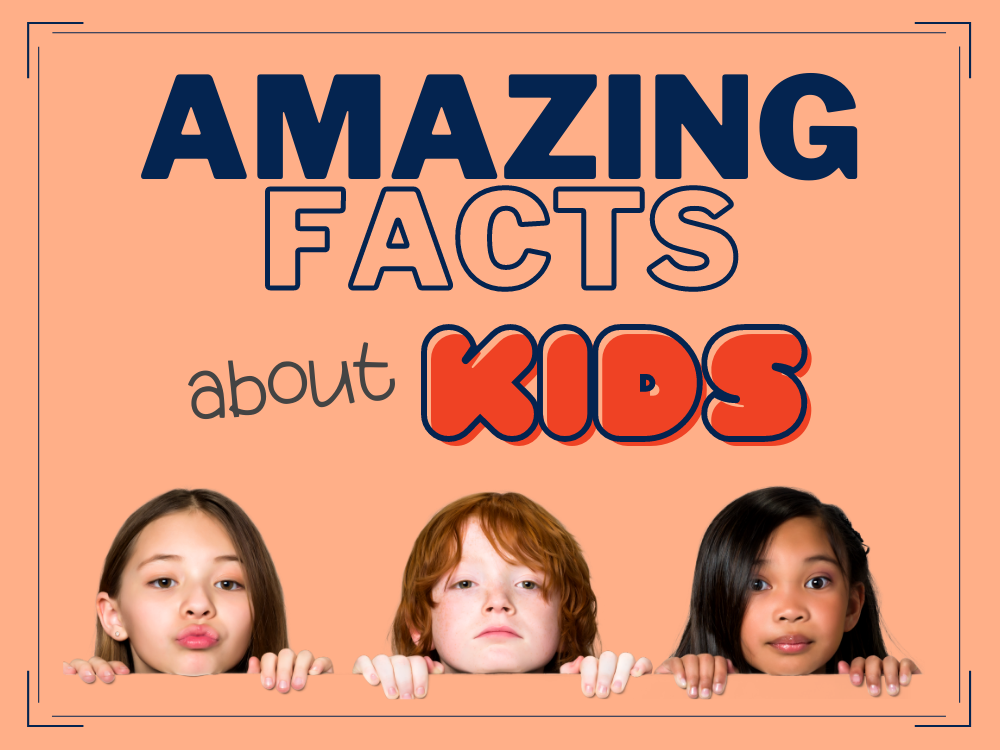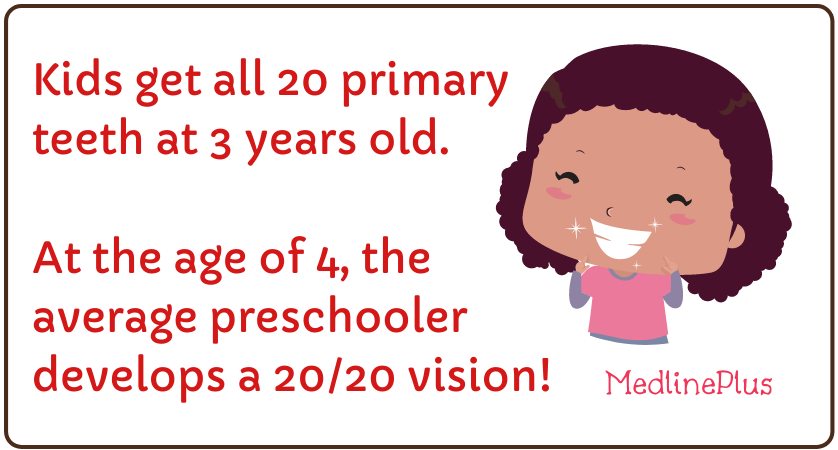
Kids are amazing little creatures. Little babies come into this world looking tiny and fragile and, before you know it, they sprout into full-sized adults!
From conception to adolescence, their circus of development is unique in every phase! These sequences of standard physical, language, thought, emotional and behavioral changes are very helpful only if you know how to identify them!
Let’s focus on the fantastic phase of childhood. Below are 100 facts that will give you a closer look at kids in general, and perhaps understand them better!

1. Out of the 7.8 billion world population today, 1.98 billion are children. Last decade, people 0-14 years old had a global population of 1.88 billion. (Statista, 2019)
2. Niger has the youngest global population. Almost 50.12% are under 15, followed by other African countries Mali, Uganda, Chad, and Angola. (Business Insider, 2019)
3. In America, 22% of the total population are children. In 2020, there were 73.1 million kids. (AECF.org, 2023)
4. In North America, kids are a little more spoiled when it comes to toys. Parents spend an average of $306 per child, annually on toys alone! (Statista, 2019)
5. 50% of American kids are White or non-Hispanic, and 25% Hispanic. Additionally, 14% are Black, non-Hispanic, and 5% are Asian, non-Hispanic. (AECF, 2020)
6. In 2017, 23% of American school-age kids spoke a language other than English at home. About 4% spoke both languages other than English at home and had difficulty speaking English. (ChildStats, 2019)
7. In 2018, 90% of kids were enrolled in US public kindergartens. Consequently, the remaining 379,00 of American children attended private kindergartens. (Statista, 2018)
8. In 2018, 92% of American elementary pupils were enrolled in public schools. Out of 32.49 million kids, only 2.82 were in private institutions. (Statista, 2018)
9. YouTube is the most popular brand for American child internet users. Food products such as Oreo, M&M’s, Hershey’s Doritos, and streaming site Netflix, are top favorites. (Emarketer, 2019)
10. Most American children ages 11 up to 18 years own a smartphone. Meanwhile, the tablet is a popular choice among three out of ten US kids below ten years old. (Emarketer, 2019)
11. Watching television is the most common daily media activity of any US child. They are also into watching online videos (56%), listening to music (47%), and playing mobile games (46%), among others. (EMarketer, 2019)
12. Watching television can be a natural painkiller for kids. A study printed by Archives of Disease in Childhood concluded that TV as a passive distraction is a better analgesic than an active distraction. The former also increases their pain tolerance. (Science Daily, 2006)
13. America has more left-handed kids than any other nation in the world! About 90% of kids are born right-handed globally. (Washington Post, 2015)
14. Kids laugh more excessively than adults. Babies and kids laugh 300 times a day and adults-only laugh an average of 17 times a day. (Association for Applied and Therapeutic Humor)
15. Children born in May are the heaviest. They are 200 grams heavier at birth compared to children born in any other month. (Lunenfield-Tanenbaum Research Institute)
16. Kids are born ambidextrous! Only 1 percent will remain ambidextrous for life, and a child will have a dominant hand by the time they reach school age.
17. Most kids hate clowns! In a study of more than 250 kids, the University of Sheffield found out that children find them frightening and unknowable! (China Daily, 2008)
18. Whether or not kids can sense the paranormal is a topic of debate.Many parents swear they do, just like the story in this Daily Mail article!
19. Children in Holland start school on their fourth birthday. Meanwhile, Finland does not start school until they are seven years old.
20. In France, kids go to school only four days a week. Additionally, to teach them about different cuisine and good table manners, mealtime is generally considered part of the French curriculum.
21. Japanese parents let their kids travel to school alone. Kids are taught to be independent in taking the subway and running errands. (Bloomberg, 2015)
22. In the Medieval Age, children are portrayed in art as less like babies and more like older adults. Having no childlike appearance with odd-features, medieval babies at the time would look like miniature adults. (WHS Blogs, 2019)
23. ….and in the 16th century, kids began to have distinct childlike characteristics. And it was at the end of 17 century that images of children were shown playing with toys. It was also during this era that children’s literature came to be.
24. The brain is the fastest-growing organ during early adulthood. At the age of 5, 90 percent of the brain is already developed.
25. Children understand what you are saying before they learn to speak. They can communicate physically, such as waving goodbye and pointing at objects, before they can communicate verbally!
26. Babies will look at the prettiest faces longer. In one UK research, they found that almost all babies spend more time looking at beautiful faces than less attractive ones. (New Scientist, 2004)
27. They can understand facial expressions. Research shows that even nine-minute-old babies prefer to look at clear images of faces rather than mixed images. (Fatherly)
28. Young children can recognize their mothers even if their sense of hearing and sight are still developing! In a section of their brain that is associated with the language process, babies can recognize their mother’s voice with just one syllable and even know their smell! (Parents)
29. …and they can recognize faces of different monkeys, too. Under six months, babies can identify faces of species other than their own, and adults and nine-month-olds cannot! (PubMed, 2002)
30. Younger children naturally have an annoying cry! Their survival skill, evolutionary biologists suggest, was made that way to get their parent’s attention.
31. They have superhero vision! Called perceptual constancy, babies can see sharper images that even average adults won’t notice immediately. (Scientific American, 2016)
32. …and supersonic ears, too! Their ears are far better at picking up higher frequencies than regular adults; that’s why they generally dislike loud bangs and fireworks!
33. Babies control us with their cuteness! From their chubby cheeks, soft skin, and sweet smell, babies are scientifically engineered to make us care for and attend to them for their survival! (EurekAlert, 2016)
34. They have more reflexes than adults. There are 70 known primitive reflexes in kids that mostly disappear as they grow. (Baby Sparks, 2016)
35. Kids at birth have a head size that is relatively the same as that of an adult. With its considerable proportion, the rest of the body parts are much smaller than adult size. (Nationwide Children’s Hospital)
36. Just wait between 6 to 10 months when babies can give you their first best smile! This social smile occurs during interaction with the people around them!
37. During the infant stage, the sleep cycle is only 50-60 minutes long. It is not until they are 4-6 months old that they learn self-soothing behaviors to help them sleep at night. (Raising Children)
38. Babies can’t taste salt until four months old. They can taste sweet, sour, and bitter, but their taste buds that sense sodium, along with their kidneys, are still developing at this time.
39. The first baby tooth appears at six months and the set of teeth gets completed after two years old. At the age of six to seven, kids lose their first tooth!
40. The speed of physical growth happens rapidly months after birth. Their birth weight doubles by the 4th month, triples by the first year, and quadruples by their 24th month!
41. Shortly before puberty, growth proceeds at a slow rate. This occurs when they age around 9 to 15 years old!
42. At birth, babies see black, white, and shades of grey only! By 3 to 4 months, they can develop their color vision, and recognize red and green. (Healthy Children)
43. Little babies don’t cry with tears. Most of them start crying with tears from two weeks to 8 weeks, during which the lacrimal ducts are developed. (Mirror, 2018)
44. Young children blink less than adults. They blink only once or twice in a minute while an adult blinks about 10 to 15 times every minute. (The New York Times, 2008)
45. Yet, children blink more frequently than adults. A study revealed that kids spontaneously blink 269 times, while adults do 179 times only. (The New York Times, 2008)
46. From 15 months to 5 years old, kids go through five stages of drawing and writing. At 15 months, kids do random scribbling. At 2 to 3 years, they perform controlled scribbling. They are able to draw lines and patterns at 2.5 to 3.5 years old. They can draw people or objects at 3 years to 5 years of age, and finally, do letter and word practice when they reach 3 to 5 years old. (ZeroToThree)
47. An average girl child reaches half her adult height faster than boys. Girls reach their normal height at 18 months, and boys do the same at 24 months.
48. It takes 9-18 months for the baby’s skull to be formed. The little one’s soft skull has sutures and fontanelles that are needed for brain growth and development.
49. Kids’ height changes in the daytime. This is due to the compression of discs in the spine from being upright all day. When children sleep, the spine decompresses. (EverydayHealth)
50. By 18 months, most children can control their bowels! Potty training can be started at this phase, but make sure they are ready physically and emotionally! (ZeroToThree)

51. Young children can benefit from language mixing when they reach between 18-24 months. As their language skills grow, they can learn two languages at the same time and combine English and home language in the same sentence. (ZeroToThree)
52. Children become aware of physical differences in gender at the age of two. By the age of three, they can label themselves as either a boy or a girl. They can establish a stable sense of gender identity as early as four years old.
53. Toddlers know when you are mad! Parents must be mindful of how powerful your emotion is when talking to your kid. Your 15-month-old can remember if you’re angry and then change his or her behavior in a neutral approach! (APA PsychNet)
54. Toddlers can walk 176 steps per minute! This explains why parents find it exhausting to run with or after them!
55. Two-year-old kids can follow a two-step command. Healthy children at this age can also tell parents if they need to use the potty or their diaper is soiled! (KidsHealth)
56. An early school-age child can follow a series of three consecutive commands. It will progress to following five commands in a row by the age of 10. (MedlinePlus)
57. Instead of baby talk, young kids can say real words like “breakfast” at two years old! They can also use at least two-word sentences like “I want!” (KidsHealth)
58. Kids have more bones than adults. They are born with nearly 300 bones and end up with only 206 by the time they become adults. Bones, like those in the skull, combine as people age. (WebMD)
59. Children can learn to use a touch screen by the age of two. With 71% of kids having access to touchscreen devices, toddlers can use these devices purposely and do common skills in touch screens such as unlock and swipe! (Research Gate, 2015)
60. Young kids with “talkative” parents know more words! By the time they reach 2, babies with parents who frequently talk will have more than 300 vocabularies compared to those who rarely speak to them.
61. The voice of a 36-month old preschooler is louder than 200 healthy adults in a crowded restaurant. No wonder these kids become the center of attention in these packed areas!
62. The birth-to-three period is the fastest rate of brain development across the entire human life span. The newborn’s brain is 1/4 the size of an adult brain, which doubles in the first year, becomes 80% functional at age three, and 90% functional at age five! (Arizona State University, 2017)
63. Young kids have four stages of language development. It starts with the babbling stage, followed by the single-word stage, and then the two-word stage, and finally the phase wherein they can string three words and sentences together.
64. At 30 months, kids ask “What?” and “Where?” questions. Additionally, kids speak using pronouns (I, me, you) at this age. (KidsHealth)
65. Children at three years old ask, “Why?” more often. They also understood spatial words like in, on, and under! (KidsHealth)
66. And at 5, they can respond to “Why?” questions. At this period, they can also understand the concept of time. MedlinePlus)
67. An average preschooler can walk up the stairs with their two feet alternating. Kids at three can also balance one foot for one second! (KidsHealth)
68. All 20 primary teeth of kids are completed by age 3. At the age of 4, an average preschooler can achieve 20/20 vision! (MedlinePlus)
69. Stuttering is normal for toddlers. At 3 to 4 years old, kids’ ideas come to mind faster than they can express them! (MedlinePlus)
70. When they reach three years old, kids can say “please” and “thank you.” They can also refer to themselves by using their name in the five-word sentence. (CHOC Children’s Hospital)
71. Kids are born without kneecaps. By the age of 3, these kneecaps start to turn bony.
72. A 4-year old child asks an average of 437 questions a day. Additionally, a child asks about 40,000 questions between the ages of 2 and 5. (3trivia, 2019)
73. The majority of kids give up napping by age 4! Their preschool also plays a significant factor in their sleeping schedule. (Parents)
74. At four years old, kids can know the basic rules of grammar! They can use “he” and “she” correctly, say their first and last name and sing “Itsy Bitsy Spider” (Center for Disease Control and Prevention)
75. Children aging four years can understand what fantasy versus reality is. These kids can also draw a person into three separate body parts. (CHOC Children’s Hospital)
76. Imaginary playmates are common among 4-year-olds. From make-believe and pretend games, this is normal for kids since they don’t have other playmates to start with. (Health Information for Western Authorities)
77. 5-year-old kids have more self-control! Compared to toddlers, these children are learning to regulate their emotions and can sit for a longer time in classrooms or listen attentively to their teachers!
78. You will often hear five-year-olds shouting, “Look at me!” These kids are more coordinated and like to show off new physical skills like riding a bike and jumping a rope. (Raising Children)
79. At five years old children can somersault! They can also swing, climb, and stand on one foot for ten seconds or longer! (Center for Disease Control and Prevention)
80. Kids can know their name, age, and address by the time of 5. They can also copy a square, a cross, and a triangle! (Health Information for Western Authorities)
81. During grade-school, kids look lankier than being chubby-cheeked. This is the time when they begin to gain muscle and lose some of their fat!
82. Kids are brilliant wordsmiths at six years old! At this age, an average child knows around 13,000 words where an average adult has a 60,000 vocabulary.
83. Six-year-old school-age children can typically focus a task for at least 15 minutes. When they reach nine years old, kids can focus for an hour, both at home and on school tasks. (MedlinePlus)
84. Kids below 6 are at the highest risk of crushing or burning injuries of the hand. This is the time that children start to appreciate the functions of their hands like eating and playing, so always keep an eye on them, parents! (EatOnHand)
85. Wait until they are seven, as kids can organize information in their memory. At this age, they can remember information better-using patterns and tricks, especially on test day!
86. Kids at 7 grow about 2.5 inches a year. Their weight also adds up to 4 to 7 pounds with a sense of body image beginning. (WebMD)
87. Baby teeth are starting to fall out for 7-year-old children. This is to make way for the permanent teeth! (WebMD)
88. By seven years of age, kids have well-developed hand-eye coordination. They also have a good sense of balance, such as riding a balance bicycle!
89. Children develop friendships with the same-sex kids during school age. They also find the opposite sex as awful and strange, but this will become less negative when they come too early adolescence. (MedlinePlus)
90. Growth spurt begins earlier for girls; lasts longer for boys. At the age of 8 to 13 years is the average puberty for females, whereas it is between 9 1/2 to 14 years for males. (CHOC Children’s Hospital)
91. Young kids can almost be able to converse at an adult level by eight years old. These children can express a clear preference for particular activities and subjects.
92. Kids at nine can read and understand longer sentences up to 12 words. They can also add and subtract two-digit numbers and understand fractions. (Mott Children’s Hospital)
93. Nine-year-old kids can remember other narratives aside from their own experiences. Also, it can be based on the perspectives of the author, the characters in the story, or their views.
94. A boy’s voice changes between 11 to 14 years old. While some change quickly, others happen gradually. (KidsHealth)
95. Girls are more prone to acne at 11 years of age. At this age, average boys show no to little signs of puberty.
96. Firstborn children tend to develop a higher IQ than their siblings. Research of the Journal of Human Resources found that eldest children outperform their younger siblings on cognitive tests. (CNBC, 2019)
97. Kids mostly spend more time with their brothers and sisters than other people. However, they often fight a lot and sometimes with a conflict every 10 minutes! (What to Expect)
98. Kids with more than three siblings make you shorter. A study involving 14,000 children showed that kids with three other siblings were one inch shorter due to less time, money, and attention given to them, according to a study. (Medindia)
99. Kid’s earliest memories are fictional. One study in the UK stated that nearly 40% of kids have “implausible memories” that don’t necessarily come from anywhere but were assembled from photos or ideas about what normal infancy involves and stories told by other family members. (ScienceAlert, 2018)
100. Kids inherit their height from fathers while they get their weight from their mothers! A study involving 1,000 families revealed that the most significant influence on a child’s weight is the mother, and taller fathers make longer babies! (BBC, 2006)

The Bottom Line
From birth to puberty, it is no secret that children undergo dramatic changes. As development is highly individualized and dependent upon both genes and the environment, these facts should help parents and adults understand, guide, and shape their kids toward growing and developing into happy and successful kids!








